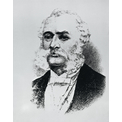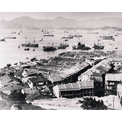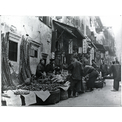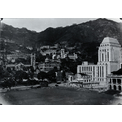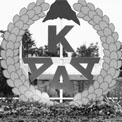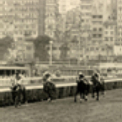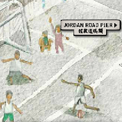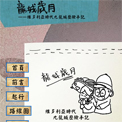 Collections
Collections Hong Kong, Benevolent City: Tung Wah and the Growth of Chinese Communities
Hong Kong, Benevolent City: Tung Wah and the Growth of Chinese Communities The Hong Kong Chinese Community in the Mid-19th Century
The Hong Kong Chinese Community in the Mid-19th Century
1. Early Governance of Chinese People by the Hong Kong Colonial Government
After the British exerted control throughout Hong Kong in 1841, the governance of Chinese people became a major problem for the colonial government. Hong Kong Island was only a short distance from mainland China and cross-border crimes were commonplace. In addition, those Chinese immigrants who came to Hong Kong to earn a living in the early days were mostly from lower socio-economic levels. Vulnerable to recruitment by gangs, they often posed a serious threat to public order. The colonial government responded by meting out severe punishment to Chinese criminals. Strict measures such as flogging, cutting of the hair queue, forced labour and shackles were used to deter crime. In 1844, the government appointed the Registrar General to handle Chinese affairs and imposed the baojia system, under which the dibao (local constable) was responsible for mediating disputes. Laws applicable only to Chinese were also implemented, such as a night time curfew that stipulated specific times when Chinese could leave their homes as long as they carried with them a lantern and their dengzhi (night pass). Initially, the Legislative Council did not include any Chinese representatives. At court, the jury was composed solely of foreign members. It was only in 1858 that Wong Shing became Hong Kong’s first Chinese juror, while the first unofficial Chinese member of the Legislative Council, Ng Choy (Wu Tingfang), was appointed in 1880.
2. Chinese Merchant, Chinese Labour and Chinese-foreign Relations in Early Hong Kong
Early Chinese merchants in Hong Kong were compradors working in companies of foreign traders. With the outbreak of the Red Bandits Rebellion in South China during the 1850s, a large number of merchants immigrated to Hong Kong from the Pearl River Delta. In the 1860s, sea transportation routes were opened between various mainland trading ports, leading to a surge in cargo traffic along China’s coast. Situated on the maritime trade lane between mainland China and Southeast Asia, and distinguished as a duty-free port, Hong Kong saw the number of Chinese-owned trading companies increase to 215 by 1876.
Hong Kong’s economy took flight. The building, repair and maintenance of marine vessels as well as cargo transportation required a large labour force. A great number of Chinese came to Hong Kong in search of opportunities, but these lowly paid Chinese workers could only afford to board at “coolie houses” or in rooms shared by several households. From time to time, there were clashes between Chinese and foreigners. In 1844, for example, Chinese merchants joined the workers’ strike against the poll tax. During the Second Opium War, the city’s labourers and merchants went on strike. In 1857, a Chinese bakery put arsenic in its bread that was presumably meant consumption of its foreigner patrons. During the Sino-French War in 1884, pier workers went on strike.
3. Early Chinese-founded organisations: Man Mo Temple, I-tsz and the District Watch Force
The Man Mo Temple in Sheung Wan was the centre of early Chinese activities. With funds donated by merchants Tam Achoy and Loo Aqui, it was renovated in 1847 and expanded to its current scale in 1851. The temple’s general committee was made up of leaders of the Chinese community who would mediate disputes as well as receive Qing government officials passing through Hong Kong. The general committee retained its leadership position until the founding of the Tung Wah Hospital.
In 1843, the Hong Kong Government designated the Tai Ping Shan District in Sheung Wan as a residential area for Chinese people. In 1851, the I-tsz was built in this area to house ancestral tablets and later, it became a place for abandoning the critically ill. Problems in managing the I-tsz aroused the government’s concern for Chinese people’s hygiene and healthcare, and directly led to the founding of the Tung Wah Hospital.
Crime was common in Hong Kong during its early years. As a result, Chinese merchants organised watchmen groups to guard against attackers. The District Watch Force, which was under the control of the Registrar General, was established in 1866 to manage watchmen in various districts. Prominent merchants who served in the District Watch Committee included merchants Sir Kai Ho Kai and Li Sing. The government would consult the District Watch Committee when addressing Chinese affairs. Like the Tung Wah Hospital, the District Work Committee was a civil organisation funded and managed by Chinese people while regulated by the government. Both organisations helped facilitate communication between the government and Chinese leaders.
4. Early Chinese Organisations and Classes: Kung So, Nam Pak Hong Association and Compradors
In the early days, organisations established by local Chinese based on geographical or trade alliances were called “kung so (communal hall)”, “hong” and “tong”. Sin On Kung So in Stanley (today’s Stanley Kai-fong Welfare Association) was formed by native residents of the area, whereas Sei Wan Yu Lan Kung So liaised with merchants of various trades in preparation for the rituals for the Yulan Festival for the residents of Ha Wan, Chung Wan, Sheung Wan and Sai Wan.
As trade between Hong Kong, mainland China and Southeast Asia flourished, merchants Ko Mun Wo and Chiu Shing Lam, among others, drew up the Nam Pak Hong Regulations in 1864 to prevent disputes within trades. Established in 1868, the Nam Pak Hong Association became the most important Chinese commercial organisation of its day. Nam Pak Hong was closely associated with the Tung Wah Hospital. Ko Mun Wo was the hospital’s founding director, while many of the hospital’s early board members were also representatives of Nam Pak Hong.
Under the gonghang system in Guangzhou, compradors worked for foreign traders by liaising with local government officials and merchants and attending to a variety of tasks. After the system was abolished, these businessmen became trade partners who were heavily relied upon by foreign merchants. As a result, they rose in status and their incomes surged. Some compradors even set up their own companies and contributed to the emergence of a new social class in the Chinese community of Hong Kong. Leung Wan Hon, a comprador at Gibb Livingston & Co, was the founding Chairman of the Tung Wah Hospital. Moreover, Nam Pak Hong merchants and compradors made large annual donations to the Tung Wah Hospital.
